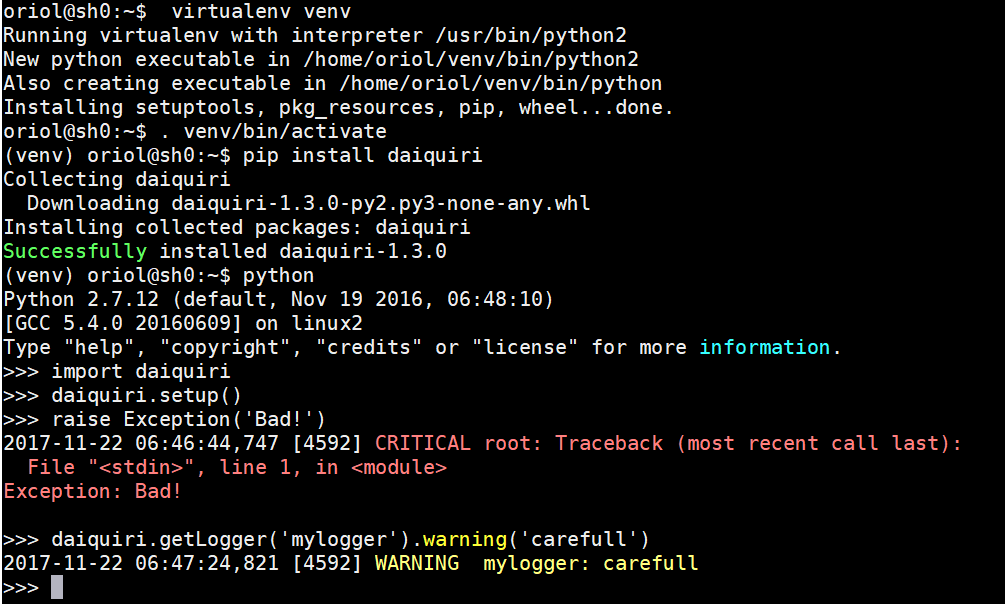Scripted Grafana dashboards
A few minutes of video for explaining how to create dashboards on Grafana using Javascript code:
The code used for hello world script is available as a gist.
Python logger, quite interesting wrapper for python logging library
Python logging library is really flexible and powerful but usually, you need some time for setting up the basics or just for logging in a simple script, some commands and settings have to be done. Daiquiri is a library which wrapper python logging library and offers a simple interface for start enjoying logging features in python. Next, there is a hello world example extracted from Daiquiri documentation which shows how easy it gets nice output from the console when you’re programming simple scripts.
Google Chrome multiple profiles for productivity
Hi everyone, some time ago Eloi gave a very good idea about how to use multiple profiles in Google Chrome for organizing different contents with different nature. And the most important thing, associate default Google accounts to the browser depending on those activities.
Next video is a description of how I use that trick.
Three headphones until I get succeed
 This is post entry is a summary of my experience with three different headphones until I found one which is compatible with Google Meet (professional version of Google Hangout). I spent a lot of hours every day working with video conference applications like Skype and others. It means stay sat for a long time, and when I don’t have to be in front of my screen I appreciate if I can walk around my room. Of course, this is only possible when the headphones that you use are wireless. A long time ago I had wired headphones and ended tired of having small incidents which damage my ears or drop off anything which was on my table.
This is post entry is a summary of my experience with three different headphones until I found one which is compatible with Google Meet (professional version of Google Hangout). I spent a lot of hours every day working with video conference applications like Skype and others. It means stay sat for a long time, and when I don’t have to be in front of my screen I appreciate if I can walk around my room. Of course, this is only possible when the headphones that you use are wireless. A long time ago I had wired headphones and ended tired of having small incidents which damage my ears or drop off anything which was on my table.
So, I decided to read some benchmarks about high-quality headphones, I considered a tool for my job and I decided to spend my money. Having my requirements as a reference and using the benchmark readings for checking them I finally bought the Sennheiser PXC550. I’m not going to say whatever you can find in regular reviews, just some words to say this is a very good product with an excellent sound quality. But, not works with Google Meet (Hangout). What I mean is my voice it could not be understood by other peers. It’s impossible to understand anything. Using applications like Skype, or phone calls the quality was very good. Or using the headphones from my mobile phone and the Google Meet application the quality was good.
Thanks to Amazon guarantee I returned the product and I bought the Bose QuietComfort 35. Also a very good product, maybe a little bit worse than the Sennheiser one in some aspects but anyway a world-class product. Problems with Google Meet (Hangout) were even worst, in this case, sound quality was bad not only from my mic also other people of conversation had a really bad quality. Again with Skype, the quality was good. But when I connect the headphones to my mobile using Google Meet the sound quality was horrible, impossible to use.
Finally, I bought the Plantronics BackBeat PRO 2 SE. From those three that I tried this is the product with less quality IMHO. But Google Meet from my laptop works, my voice quality is not very good but it’s good enough for using them. Again I’m talking about a very good product, with a very good quality. In front of the other two, these ones are weighty, old fashion design, less comfortable, and worst sound quality. Some advantages that I found, the most important of course is it works with Google Meet (Hangout). The sound is louder at the maximum volume, and there are physical buttons for mute and on/off/pairing. Another advantage is the Bluetooth class 1 which give better coverage when I’m not next to the computer.
I didn’t say anything so far, but I’m talking always about Bluetooth connections with my laptop where I have a Windows 10 installed with Google Chrome. Laptop Bluetooth version is 4.0 HCI and LMP version: 6.1280 manufactured by Intel and driver version is 19.30.1646.853 (date: 2016-11-14).
If anybody knows a little bit more about this topic or wants to exchange any similar experience I’ll appreciate.
Raspberry PI: using read-only root partition
Two years ago I wrote an article discussing how to set up OpenWRT filesystem configuration for controlling writes in the flash card: Raspberry PI and OpenWRT flash partition proposal and rescue boot support for embedded systems.
This current article is mainly for referencing a very good article about how to work with Raspbian with a read-only filesystem and share a fast and dirty cookbook about how to play with that. First of all the reference to: Protect your Raspberry PI SD card, use Read-Only filesystem.
My cookbook about how to get the essence of that article is simple, locate in your /etc/fstab file the line:
/dev/mmcblk0p2 / ext4 defaults,noatime 0 1and modify that line with:
/dev/mmcblk0p2 / ext4 defaults,noatime,ro 0 1After rebooting your system is going to work in read-only mode. I don’t remember if I modified anything else of the booting process but I don’t thing so.
Because sometimes I have to modify anything in the flash card, I added the next two lines in the ~/.bashrc file:
alias rw='sudo mount -o remount,rw / ; sudo mount -o remount,rw /boot' alias ro='sudo mount -o remount,ro / ; sudo mount -o remount,ro /boot'
Now just with the command rw it’s really easy to get the root filesystem in the write mode, and when I finish my updates just typing ro it’s go back to read-only mode.
I hope it’s useful for you.
Cryptomator: create a secure vault for your files
 Yesterday I found a tool called Cryptomator, this is a client-side encryption for your files. You can use it with Dropbox, or any other cloud filesystem or you can use it in your local filesystem. Anyway, this open-source piece of software is really simple to install and is compatible with Windows, Mac and Linux. Once this is installed, using the UI the only thing we have to do is create, or select, a folder where the secure vault is going to be created. It uses a symmetric password for cyphering and when the vault is unlocked a new removable drive appear in your system. So, at the end, the vault is like a pendrive and there is no complexity on add, rename, remove, create folders, etc. inside the new drive. Once the vault is locked, the removable drive is unmounted and if you go to the location where the vault is created a tree structure with cyphered files is the only thing that you can see. Cryptomator works cyphering each file, not the complete vault as a package.
Yesterday I found a tool called Cryptomator, this is a client-side encryption for your files. You can use it with Dropbox, or any other cloud filesystem or you can use it in your local filesystem. Anyway, this open-source piece of software is really simple to install and is compatible with Windows, Mac and Linux. Once this is installed, using the UI the only thing we have to do is create, or select, a folder where the secure vault is going to be created. It uses a symmetric password for cyphering and when the vault is unlocked a new removable drive appear in your system. So, at the end, the vault is like a pendrive and there is no complexity on add, rename, remove, create folders, etc. inside the new drive. Once the vault is locked, the removable drive is unmounted and if you go to the location where the vault is created a tree structure with cyphered files is the only thing that you can see. Cryptomator works cyphering each file, not the complete vault as a package.
So far I installed the tool on my Windows computer for securing some sensitive files that I have on my laptop. But if it works like I expect I’m going to extend the usage with the rest of my computers. As I said it’s not required any cloud filesystem, by the way, I use Cryptomator in conjunction with Resilio Sync.
